|
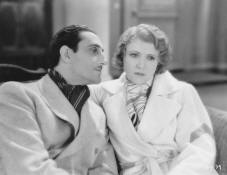
The Lady of Scandal was originally called
The
High Road, the same title as Frederick Lonsdale’s play upon which the
film is based. The change in title (announced in The
Film Daily, April 24, 1930) is puzzling because there is no scandal
involved on the part of Ruth Chatterton's character. When released in
England, the film kept the original title The High Road.
Ruth Chatterton plays Elsie,
the popular star of a musical comedy show in London. One of her admirers
is Lord Teylesmore (Ralph Forbes) who falls head over heels in love with
her. Every day for a year, he has asked her to marry him, and though she is
fond of him, each time he proposes, Elsie turns him down. Hoping to force
the issue, Lord Teylesmore, whose given name is John, places an ad in the
newspaper announcing their engagement.
John's family is horrified to learn of his
engagement to an entertainer. A diplomatic career of importance is intended
for John, so an appropriate wife would be a woman from an aristocratic
family. Apparently the stiff-lipped upper-class Brits viewed singing and
dancing as "unlady-like" or even scandalous. Such a woman could not become
Lady Teylesmore.
Hoping to stop this marriage, John's father,
Lord Crayle, sends Elsie a letter, offering her five thousand pounds if she
will break her engagement with John. Unfortunately for him, the attempt to
buy her off only angers Elsie, and makes her determined to go through with
the marriage. John's father proceeds to convene a family council to help him
figure out how to deal with this family crisis. John's uncle and aunt, Lord
and Lady Trench; his cousins, Alice and Ernest; Lady Minster, another aunt;
and Sir Reginald Welby, also an uncle, all gather at the Crayle estate. Also
present is John's favorite cousin Edward, the Duke of Warrington (Basil
Rathbone).
Educational Screen published this review:
|
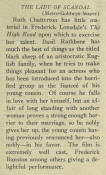 Ruth Chatterton has little material in
Frederick Lonsdale’s The High Road upon which to exercise her
talent. Basil Rathbone has much the best of things as the titled
black sheep of an aristocratic English family, when he tries to make
things pleasant for an actress who has been introduced into the
horrified group as the fiancée of his young cousin. Of course he
falls in love with her himself, but an affair of long standing with
another woman proves a strong enough barrier to their marriage, so
he nobly gives her up, the young cousin having previously renounced
her—also nobly—in his favor. The film is extremely well cast.
Frederick Bunston among others giving a delightful performance. Ruth Chatterton has little material in
Frederick Lonsdale’s The High Road upon which to exercise her
talent. Basil Rathbone has much the best of things as the titled
black sheep of an aristocratic English family, when he tries to make
things pleasant for an actress who has been introduced into the
horrified group as the fiancée of his young cousin. Of course he
falls in love with her himself, but an affair of long standing with
another woman proves a strong enough barrier to their marriage, so
he nobly gives her up, the young cousin having previously renounced
her—also nobly—in his favor. The film is extremely well cast.
Frederick Bunston among others giving a delightful performance.
—Educational Screen, September 1930 |
John's father invited Edward because, as head of
the family, Edward should offer an opinion on John's engagement. But
Edward is the one whose life is really scandalous. For some years, Edward
had been devoted to a married woman, Lady Helen Hale—and he was,
therefore, in the eyes of the family, a disgrace! At one time Lady Hale
planned to divorce her husband, Lord Victor Hale, in order to marry
Edward, but then Victor became an invalid, and she couldn't bring herself
to leave him. As a result, she and Edward carried on an extramarital
affair.
As the "black sheep" of the family, Edward had experienced
the disdain of other members of his family. So he feels empathy toward Elsie, when
his family complains about her.
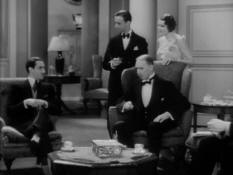
The family explains the situation to Edward. |
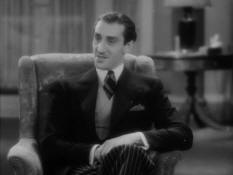
Finding it amusing that the family objects to John marrying an
actress, Edward asks, "Is she a good actress?" |
When John arrives, he has Elsie with him.
After introductions, Elsie tells the family that if they can give her one
good reason why she should not marry John, she'll give him up. She leaves
the room to let the family discuss the matter in private. Edward
accompanies her to the library, and endeavors to distract her. Elsie feels
it was a mistake to come there, but when she starts to leave, Edward
convinces her to stay.
Meanwhile, Elsie's father, Mr. Hilary,
arrives at the house. To the surprise of John's family, Mr. Hilary pleads
with Lord Crayle to stop this marriage. Elsie's a genius on the stage,
says her father, so he doesn't want her to leave the
stage for a man she doesn't love.
Edward proposes that Elsie put off
marrying John for 6 months. He offers the family the idea of inviting Elsie for a trial visit
in the household, convincing them that she will be bored to death and will
change her mind about marrying John. They assume that she will become so bored
with the family that she will change her mind about marrying John. Lord Crayle
agrees to the plan; he suggests to Elsie that she announce her retirement from the
stage and experience the sort of live she will have once she's
married.
Harrison’s Reports published the
following review:
|
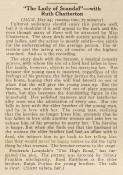 Cultured audiences should enjoy this
picture well, but it is doubtful if it will appeal to the rank and
file, even though many of them will be attracted by Miss Chatterton.
The story deals with society people, lords and ladies, and the action
is mostly subtle—too subtle for the understanding of the average
person. The direction and the acting are, of course, of the highest
standard. And so is the recording. Cultured audiences should enjoy this
picture well, but it is doubtful if it will appeal to the rank and
file, even though many of them will be attracted by Miss Chatterton.
The story deals with society people, lords and ladies, and the action
is mostly subtle—too subtle for the understanding of the average
person. The direction and the acting are, of course, of the highest
standard. And so is the recording.
The story deals with the heroine, a
musical comedy actress, with whom the son of a lord had fallen in
love. His family, however, objects to his marrying her. But because
the young man is insistent, regardless of the feelings of his parents,
the father invites the heroine at his home, hoping that she will find
herself so out of place that she will give the young man up. But the
heroine, not only does not feel out of place amongst them, but also
becomes the dominating figure in the household. Her polished manners
and her intellectuality soon win the admiration of every one. But she
falls in love with the elder brother of the young man, and he in love
with her. The young man, realizing that the heroine no longer loves
him, pretends that he has fallen in love with another woman and asks
her to release him of his promise to marry her. The heroine is happy.
But when she finds out that the husband of the woman the elder brother
had had an affair with is dead, she induces him to go back to her
telling him that they would never be happy unless he did the right
thing by that woman. The heroine returns to the stage.
Frederick Lonsdale’s “The High Road,”
has furnished the plot. The picture was directed by Sidney Franklin
intelligently. Basil Rathbone is the elder brother, Ralph Forbes the
young brother. The talk is clear.
—Harrison’s Reports, June 21, 1930 |
The plan to bore Elsie so that she would yearn to return to the stage
backfires. Three weeks after she moved in, there is music in the house.
She has endeared herself to Lord Crayle, whom she affectionately calls "Craylie."
Edward comes over to the house at least three times a week to enjoy
Elsie's company. Elsie enjoys his company, too. They are falling in love.
When Elsie learns that Edward is leaving for Paris in the morning, she
contrives an excuse to speak with him in private. He blurts out that he
loves her, and says he's going to Paris to see Lady Helen Hale and break
off their relationship. He felt he needed to do it in person. And then he
wants to marry Elsie. After talking of their love and making plans for the
future, they hurry off to dress for dinner.
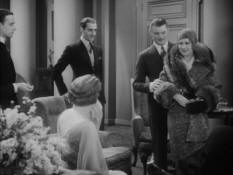
John introduces Elsie to the family. |
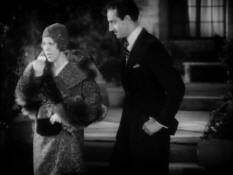
Elsie tries to leave the house. |
While the family is gathered and waiting for
dinner, Ernest turns on the radio to hear the weather report. They hear
the news that Lord Victor Hale has died suddenly. This means that his
widow, Helen, is now free to marry Edward—just as he's about to break off
their relationship! What does this mean for Edward and Elsie?
John comes to realize that Elsie loves Edward. Like a true gentleman,
he doesn't confront her or accuse her of betrayal. He gives her a gracious
way out of their betrothal by telling her that he accepted an appointment
to India, and it wouldn't be fair to ask her to wait.
Elsie tells the butler to put through a long-distance call to
Paris, to Lady Victor Hale.
|
 Frederick Lonsdale’s play, “The High
Road,” comes to the screen as a talker under the title of “Lady of
Scandal,” but there’s little scandal in the lady and nothing of
consequence in the picture itself. Frederick Lonsdale’s play, “The High
Road,” comes to the screen as a talker under the title of “Lady of
Scandal,” but there’s little scandal in the lady and nothing of
consequence in the picture itself.
As a program picture of ordinary
strength, audiences will accept it as mildly interesting. It cannot
hope to reach beyond that classification. The story has an English
background, and the rather slow and draggy stage tempo has not been
eliminated in the screen adaptation. But it is doubtful whether or not
anything better could have been done with the material at hand.
Ruth Chatterton is spotted in the title
role and provides most of the sparkle on the otherwise dull surface.
Balance of the cast, including Ralph Forbes and Basil Rathbone, fit in
nicely into their characterizations. Sidney Franklin had little chance
to show anything in direction beyond regulation formula of translating
a stage play to the screen, retaining the staginess thereby.
The story concerns a popular English
actress who consents to marry a young nobleman. The latter takes her
to meet his family, who are up in arms over his intentions. After
piling insults on the girl, an agreement is reached whereby she will
wait six months before marrying the boy.
The girl lives on the estate and
gradually puts pep into the staid members of the family. In so doing,
a secret love affair develops between the actress and Basil Rathbone,
cousin of the intended bridegroom, who is rather noted for his way
with women. The girl discovers Rathbone’s affair with the wife of
another and decides to forget him. But Rathbone makes ardent love and
declares he will give up his current affair. Discovery is made the
woman’s husband has died in Paris, and Chatterton demands Rathbone
make the trip to tell the widow of his new and greater love. While
Rathbone is writing instead of going, Chatterton gets the widow on the
phone and has Rathbone agree to come to Paris at once. Then the usual
“it couldn’t have been otherwise” parting.
Close comes soon after with the young
son deciding to release the actress from her engagement; and she
returns to her old life on the stage as the reigning favorite.
“Lady of Scandal” will probably reach
those week runs where Ruth Chatterton commands drawing power. It is a
weak programmer and is better geared for the one and two day stands
where business stands up as a matter of routine.
Draw comedies are badly needed with this
one.
—review by Walter R. Greene, Motion Picture News, May 31, 1930
|
Elsie convinces Edward that he must talk to Lady Hale on the phone and
explain that he had met someone else. But Edward couldn't bring himself to
tell Helen what had happened. Elsie is not surprised, and tells him it
could never have worked between them. She and Edward could never have been
happy as long as he still had feelings for Helen. Elsie decides to return
to the stage, and she tells Edward to go to Helen.
The film ends with Elsie back on stage, singing the same song she was
singing at the beginning of the film ("Say It with a Smile").
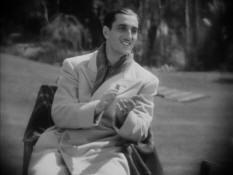
Edward watches Elsie play tennis.
"Good shot, Elsie!" |
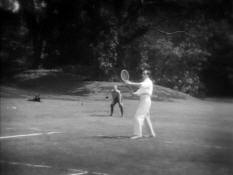
Edward playing tennis |
The Lady of Scandal was one of four films BR made
for MGM in 1930, while
he was under contract to MGM. (The four films are The Last of
Mrs. Cheyney, The Bishop Murder Case, This Mad World, and The Lady
of Scandal. After making these four films, MGM loaned Rathbone out to
other studios.) Rathbone was earning a salary of $2500 per week while
under contract. (source: “The Crowded Hour” by Samuel Richard Mook,
Picture Play, June 1931, pp. 30-31)
Rathbone later complained to Sam Goldwyn about how
he was
treated while under contract. "After 'Cheney,'" wrote Rathbone, "I was
typed & I was allowed to do nothing but 'teacup & white tie parts.'"
(source: letter from Basil Rathbone to Sam Goldwyn, dated 2 December 1936)
The Lady of Scandal certainly fits into that "teacup & white tie"
category.
Review from New Movie magazine:
|
 Metro-Goldwyn happily borrowed Ruth
Chatterton from Paramount to play the shrewdly understanding actress
heroine of what was once a stage play called “The High Road.” This is
one of those swanky studies of British life. Drawing-room dramas, they
used to call them in the old stage days. Miss Chatterton is adroit and
sure as the actress who sends the man she loves back to the woman he
has loved. And she is ably aided by Basil Rathbone as the man. This is
tastefully directed and acted. It will hold you mildly, unless you
buck at folks who hide their breaking hearts behind a teacup. The
talkies, by the way, have been going in for this polite drama pretty
heavily. Metro-Goldwyn happily borrowed Ruth
Chatterton from Paramount to play the shrewdly understanding actress
heroine of what was once a stage play called “The High Road.” This is
one of those swanky studies of British life. Drawing-room dramas, they
used to call them in the old stage days. Miss Chatterton is adroit and
sure as the actress who sends the man she loves back to the woman he
has loved. And she is ably aided by Basil Rathbone as the man. This is
tastefully directed and acted. It will hold you mildly, unless you
buck at folks who hide their breaking hearts behind a teacup. The
talkies, by the way, have been going in for this polite drama pretty
heavily.
—New Movie magazine, July-December 1930 |
Reviews were generally positive, although a few were not so favorable.
Exhibitors Herald-World (August 9, 1930) described The Lady of Scandal
as a "slow draggy story lacking in
interest and human appeal."
Mordaunt Hall of The New York Times
reported:
"The talking pictorial version of Frederick Lonsdale's play," The High Road,"
which is now at the Capitol, is deserving of high praise, for it is not only
acted by understanding players, who fill the various rôles most
intelligently, but it is a film widely removed from the conventional
screen offering. In it the producers have captured the moods and movement
of the original work and they do not cater to popular fancy by giving the
usual insipid, blissful closing scenes. . . .
Basil Rathbone gives an expert performance as the Duke." (published
June 14, 1930. Read the complete review here:
http://www.nytimes.com/movie/review?res=9807E2D91338E03ABC4C52DFB066838B629EDE
)
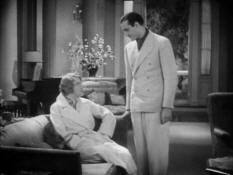
Edward and Elsie find excuses to meet and confess they love each
other. |
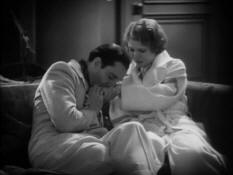
"I want to put my arms around you and kiss you so much." |
The National Board of Review magazine gave this very nice
review:
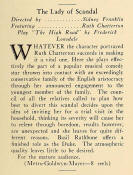 Whatever the character portrayed, Ruth Chatterton
succeeds in making it a vital one. Here she plays effectively the
part of a popular musical comedy star thrown into contact with an
exceedingly conservative family of the English aristocracy through
her announced engagement to the youngest member of the family. The
council of all the relatives called to plan how best to divert this
scandal decides upon the idea of inviting her for a trial visit in
the household, thinking its severity will cause her to relent
through boredom, results however, are unexpected and she leaves for
quite different reasons. Basil Rathbone offers a finished role as
the Duke. The atmospheric quality leaves little to be desired. Whatever the character portrayed, Ruth Chatterton
succeeds in making it a vital one. Here she plays effectively the
part of a popular musical comedy star thrown into contact with an
exceedingly conservative family of the English aristocracy through
her announced engagement to the youngest member of the family. The
council of all the relatives called to plan how best to divert this
scandal decides upon the idea of inviting her for a trial visit in
the household, thinking its severity will cause her to relent
through boredom, results however, are unexpected and she leaves for
quite different reasons. Basil Rathbone offers a finished role as
the Duke. The atmospheric quality leaves little to be desired.—The
National Board of Review magazine, May-June, 1930 |
Ruth Chatterton got an honorable mention by
Photoplay in its list of Best Individual Performances of 1930.
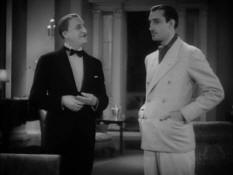
Uncle Reggie suspects that Edward and Elsie have fallen in love. |
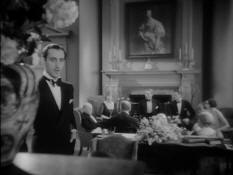
The news on the radio announces that Lord Victor Hale died suddenly. |
Ralph Forbes, who played John, and Ruth Chatterton were
husband and wife in real life.
Picture Play, gives us this review:
|
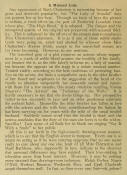 Any appearance of Ruth Chatterton is
interesting because of her great and deserved popularity, but “The
Lady of Scandal” does not present her at her best. Through no fault of
hers the picture is tedious, a tired effort on the part of Frederick
Lonsdale from whose play, “The High Road,” it is adapted. The fatigue
and the uninspired quality of the original are preserved with unusual
fidelity. This is enhanced by the efforts of the camera man to
emphasize Miss Chatterton’s plainness. It is as if one of those subtle
studio feuds were going on, aided and abetted by whoever chose Miss
Chatterton’s dresses which, except in the music-hall scenes, are far
from becoming. However, to our muttons. Any appearance of Ruth Chatterton is
interesting because of her great and deserved popularity, but “The
Lady of Scandal” does not present her at her best. Through no fault of
hers the picture is tedious, a tired effort on the part of Frederick
Lonsdale from whose play, “The High Road,” it is adapted. The fatigue
and the uninspired quality of the original are preserved with unusual
fidelity. This is enhanced by the efforts of the camera man to
emphasize Miss Chatterton’s plainness. It is as if one of those subtle
studio feuds were going on, aided and abetted by whoever chose Miss
Chatterton’s dresses which, except in the music-hall scenes, are far
from becoming. However, to our muttons.
The tarnished gem of a plot concerns an
actress whose engagement to a youth of noble blood arouses the
hostility of his family, not because she is, as the title falsely
informs us, a lady of scandal, but because she appears on the stage in
a sedate musical number. Treated rudely, according to the best
traditions of protesting families on the screen, she finds a
sympathetic oasis in the elder brother of her fiancé and acquiesces to
the suggestion of the head of the family to abandon temporarily her
unseemly career and remain with them for a few months, this musty
situation recalling Norma Shearer’s “The Actress” nee “Trelawney of
the Wells.” It is hardly necessary to say that she livens things up.
Her prospective father-in-law succumbs to jazz and an older gentleman
contracts the cocktail habit. Meanwhile the elder brother has fallen
in love with the actress and she with him, notwithstanding the liaison
he has been carrying on for years with the wife of the usual invalid
husband. Suddenly comes word that the invalid is dead, and the actress
concludes that the duty of the man she loves is to the widow.
Sacrifice! Last scene of all finds her in black net singing “Say it
with a Smile” to her public.
All this is set forth in the nigh-comedy
drawing-room manner, which is to say that the English accent is
rampant. Every one is so intent on acting as if he were uttering
epigrams that no one seem really to care about any one else, least of
all Miss Chatterton and Basil Rathbone, who, supposedly in love,
indicate to the observer that personal differences may have existed.
Their love-making is toleration more than heart interest. However, it
may be nothing more strained than drawing-room technique.
—"The Screen in Review" By Norbert Lusk,
Picture Play, September 1930
|
Motion Picture News (Sept. 6, 1930)
reported on one theatre owner's clever stunt to promote The Lady of
Scandal in El Paso, Texas. W.H. Hempill, manager of the Wigwam Theatre in
El Paso, hired a girl and had her wear a "newspaper dress" — "a dress made
out of newspapers with the scandal headlines showing up very prominently.
The girl also carried a sign on her back giving title of picture, star,
theatre and playdates. She paraded the crowded streets and shops on
Saturday in advance of picture’s opening. This caused so much comment that
the newspaper came out with a story about the ballyhoo—giving picture,
theatre and playdates. . . . plenty of interest was occasioned with
word-of-mouth publicity spreading like wildfire. As a result of this,
Hemphill was able to report that his business had jumped considerably."
The girl in a newspaper dress was a successful
promotional stunt, but an odd one, because the film had nothing to do with
newspaper stories or tabloid gossip.
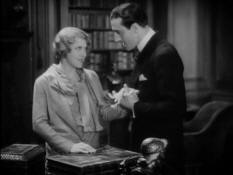
"There's no power on earth that can ever make me give you up." |
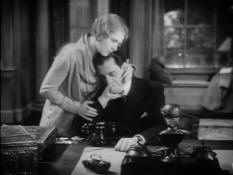
"My dear, you had to! There was no other way!" |
The following review is from Variety:
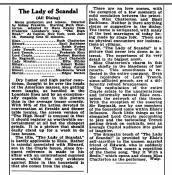 Dry
humor and high parlor causticism, thought to be over the heads of
the American masses, are getting more laughs, as handled in the
Lonsdale lines and by an exceptionally capable cast in this picture
than in the average teaser comedy. With 90% of the action devoted to
conversation at fireside and dinner table locales, the screen
version of "The High Road" is unusual in that it should register as
worthwhile entertainment at all but the cheapest grinds. It is a
picture that should easily stand up for a week in deluxe houses. Dry
humor and high parlor causticism, thought to be over the heads of
the American masses, are getting more laughs, as handled in the
Lonsdale lines and by an exceptionally capable cast in this picture
than in the average teaser comedy. With 90% of the action devoted to
conversation at fireside and dinner table locales, the screen
version of "The High Road" is unusual in that it should register as
worthwhile entertainment at all but the cheapest grinds. It is a
picture that should easily stand up for a week in deluxe houses.
The title, "The Lady of Scandal," is hardly applicable to Elsie.
Rather is scandal associated with Edward, son in the Crayle house,
since frequent reference is made to his affair with an unintroduced
married woman, while the only evidence against Elsie in this
household is that she comes from the stage.
There are no love scenes, with the exception of a few moments of
mild osculation between the principals, Miss Chatterton and Basil
Rathbone. Neither is there anything risque or suggestive in the
dialog. The theme is antiquated, with many of the best marriages of
today being made by stage folk. There are no physical encounters nor
insinuations at villainy.
Yet, "The Lady of Scandal" is a picture that never lets down in
interest. The expertness of its very detail is its biggest asset.
Miss Chatterton's charm in this lies chiefly in the blandness of
her retorts. This smoothness is reflected in the entire company.
Even the rejoinders of Lord Trench, sinus-afflicted grouch, are of a
differently refined brusqueness.
The capitulation of the entire Crayle estate to the
unostentatious and informally natural Elsie comprises the network of
this theme. With the exception of the sneering Sir Reginald, one by
one members of the household come within Elsie's influence. Such
little things as the elongated Lord Crayle succumbing to jazz and
the teetotaling Trench getting drunk on cocktails, sent an average
Capitol audience into gales of laughter.
The dramatic touch of "The Lady of Scandal" is provided by
Elsie's self-sacrifice to the unseen married friend of Edward, who
is suddenly widowed. Then comes a repetition of the theme song, "Say
It With a Smile," which opens and closes Miss Chatterton as the
performer.
—review by Waly, Variety, June 18, 1930 |
To me, the film seems rather "hoity-toity." Also, there's way too much talking in this film, but
hearing talking in films was still relatively "new" for filmgoers
in 1930, so they probably enjoyed it.
Interestingly, a year before The Lady of Scandal was released,
Rathbone told Exhibitors Herald-World that a successful motion
picture must not be merely an adaptation of a stage play. "The motion
picture screen, just because it has found voice, must not lose its
flexibility," he said. "It is the action of the motion picture that counts
and is responsible for its popularity. A talking picture, as I see it in
the future, will not be an adaptation of a stage play. In all probability,
stage plays, except for classics or notable old successes, will be
entirely discarded as unsuited for the needs of the talking screen. The
dialogue of the stage is very fine but that does not mean that it is well
suited for pictures." (source: Exhibitors Herald-World, June
22, 1929, p. 110)
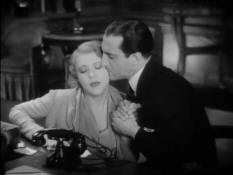
"You and I would never have been able to kiss each other without her
standing between us." |
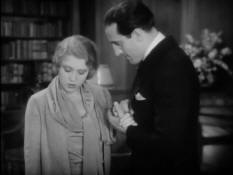
"I shall return to the theatre," declares Elsie. |
See Page Two for screenshots from the
film. See Page Three for pictures of posters,
lobby cards and promo photos.
.
|
Cast |
|
|
Basil Rathbone ... |
Edward |
|
Ruth Chatterton ... |
Elsie |
|
Ralph Forbes... |
John |
|
Nance O'Neil
... |
Lady Trench |
|
Frederick Kerr
... |
Lord Trench |
|
Herbert Bunston ... |
Lord Crayle |
|
Cyril Chadwick
... |
Sir Reginald |
|
Effie Ellsler
... |
Lady Minster |
|
Robert Bolder
... |
Hilary |
|
Moon Carroll
... |
Alice |
|
MacKenzie Ward
... |
Ernest |
|
Edgar Norton
... |
Morton |
| |
|
|
|
|
Credits |
|
| Production
Company ... |
MGM |
|
Director ... |
Sidney Franklin |
|
Writer ... |
Frederick Lonsdale (author of "The High Road") |
|
Scenario ... |
Hans Kraly |
| Cinematographers
...
|
Oliver T. Marsh, Arthur Miller |
| Film Editing
... |
Margaret Booth |
|
Art Director ... |
Cedric Gibbons |
|
Recording Director ... |
Douglas Shearer |
|
Sound Recording Engineer
... |
Charles E. Wallace |
|
Costumes ... |
Adrian (gowns) |
|
Dialogue Adaptation ... |
Claudine West, Edwin Justus Mayer |
|
Choreographer ... |
Sammy Lee |
| |
|
|
|
.
|




























